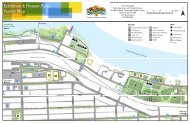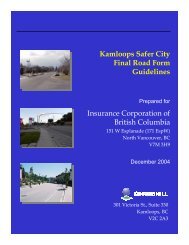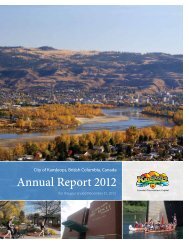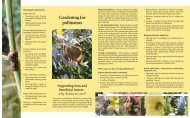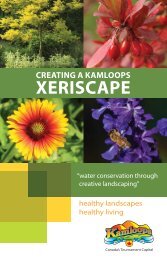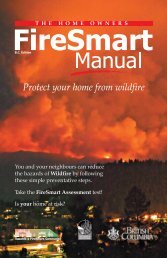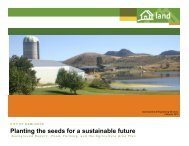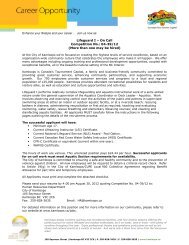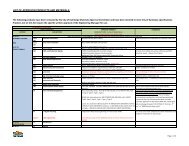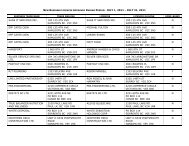GEOTOUR GUIDE - City of Kamloops
GEOTOUR GUIDE - City of Kamloops
GEOTOUR GUIDE - City of Kamloops
You also want an ePaper? Increase the reach of your titles
YUMPU automatically turns print PDFs into web optimized ePapers that Google loves.
(sTop 16) Where does our GarBaGe Go?<br />
To The CiTy landfill (But much gets recycled)<br />
Figure 60. Garbage is weighed in at the <strong>City</strong> <strong>of</strong> <strong>Kamloops</strong> Mission<br />
Flats landfill, and charged accordingly. Prior to drop <strong>of</strong>f, <strong>City</strong><br />
staff inspect for items that can be reused or recycled. (Photo by<br />
R..Turner)<br />
How well do we manage our solid waste? How<br />
effectively do we reuse materials or recycle what we<br />
do not reuse? Dealing with garbage is a major task<br />
for local governments. Landfills sites are difficult to<br />
find, and expensive to operate. The <strong>City</strong> <strong>of</strong> <strong>Kamloops</strong><br />
is trying to divert recyclable material from its<br />
landfill as much as possible. It operates a landfill at<br />
Mission Flats west <strong>of</strong> downtown along the Thompson<br />
River, and to the east at Barnhartvale. The Mission Flats landfill also handles recycling for glass, paper, cardboard,<br />
plastics, and other scrap materials (see the <strong>City</strong> <strong>of</strong> <strong>Kamloops</strong> website for more information; www.kamloops.ca ).<br />
leT’s folloW your load <strong>of</strong> GarBaGe inTo The mission flaTs landfill.<br />
The Mission Flats landfill lies on the southern slopes <strong>of</strong> the Thompson River valley west <strong>of</strong> the downtown. As you drive in,<br />
attendants help you identify things that you can leave at the “Drop and Shop” reuse store, as well as recyclables such as scrap<br />
metal, ovens and refrigerators. There is no charge for bringing reuse articles or recycling – but there is a fee for any garbage<br />
dropped <strong>of</strong>f. Freon is removed (there is a small fee) from old refrigerators before they are compacted and trucked to the Vancouver<br />
area for scrap metal, ultimately to be smelted into new products. If you still have garbage in your vehicles, you weigh in on drive-<br />
through scales and then dump your garbage into bins. Vehicles are reweighed on departure, the dumping charge is calculated,<br />
and you pay the fee. This garbage is hauled by truck uphill to the landfill where it is dumped, compacted with other garbage and<br />
covered with soil. The soil cover material is glacial till (see Stop 8) that is dug from the slopes above the landfill. More garbage is<br />
piled on top <strong>of</strong> the soil cover, and covered by additional soil. In this way, the landfill buries garbage in pods encased in layers <strong>of</strong><br />
soil. Leachate created by rain and snowmelt that percolates through the landfill is captured in pipes below the landfill and piped<br />
to the nearby <strong>City</strong> waste water plant for treatment.<br />
Figure 61b. Recycled materials such as refrigerators and tires are also removed<br />
from loads entering the landfill.<br />
34<br />
did you KnoW? Mastodon tusks were discovered in<br />
2001 during road construction at the landfill.<br />
Figure 61a. Items that can be reused are identified at the “Drop and Shop”<br />
reuse store as vehicles enter the landfill site.<br />
Figure 61c. Garbage is dumped in the landfill and then compacted by<br />
tractor and covered with soil. (Photos by R.Turner)




